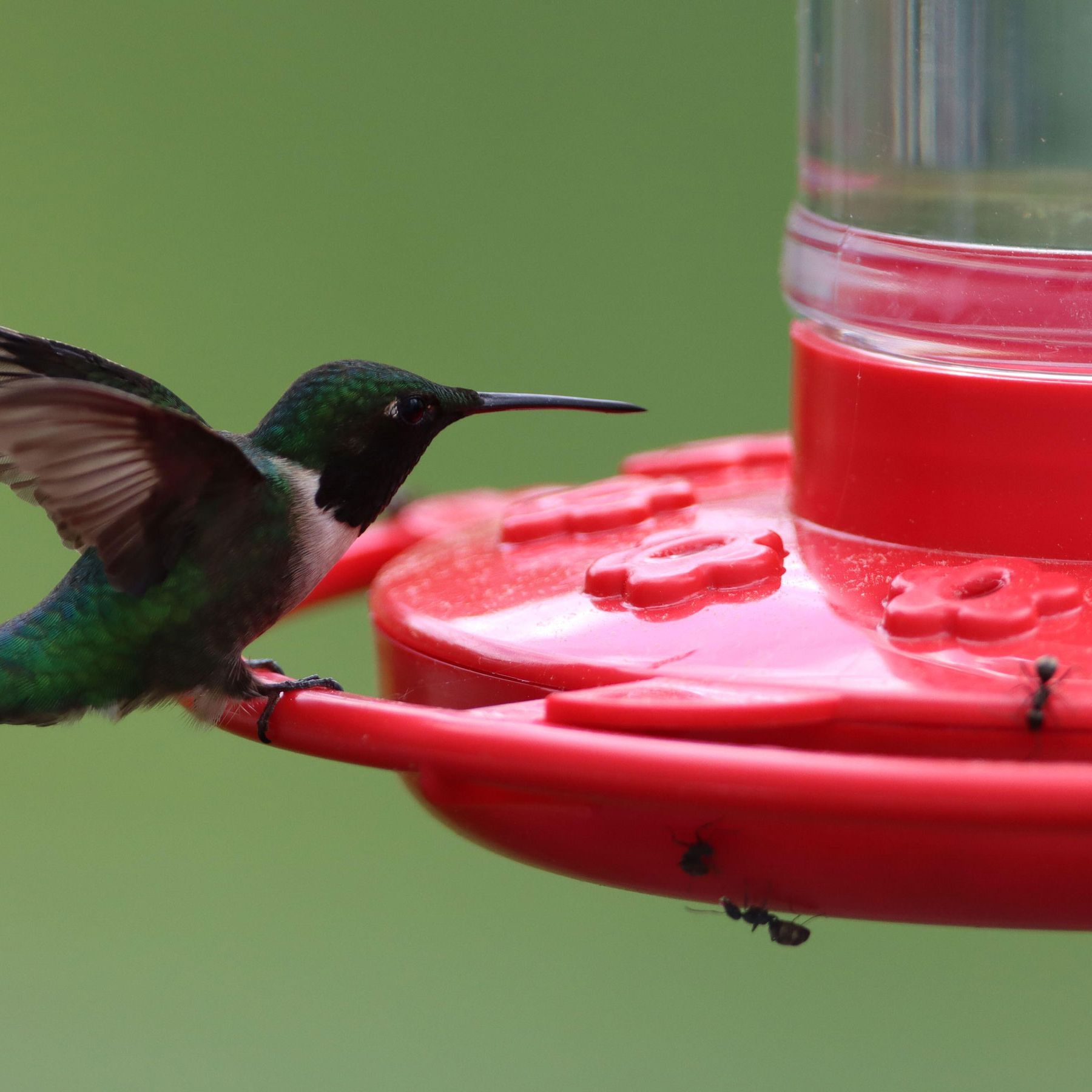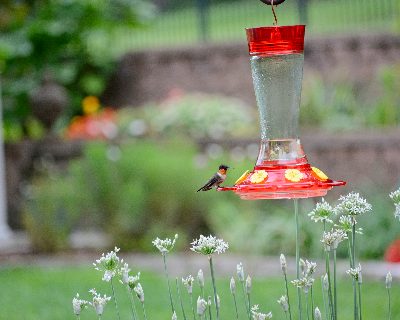If you love watching hummingbirds dance around your garden, you probably want to give them the best food to keep them coming back. But what exactly is the best thing to feed hummingbirds?
You might be surprised to learn that the right choice is simple, natural, and easy to prepare. Keep reading, and you’ll discover the secret to attracting these tiny, vibrant birds and helping them stay healthy and full of energy. Your garden will become their favorite spot in no time!

Credit: www.allaboutbirds.org
Hummingbird Diet Basics
Understanding the basics of a hummingbird’s diet helps you provide the best food to attract and nourish these tiny birds. Their diet is unique because of their fast metabolism and high energy needs. Knowing what they naturally eat and what nutrients they require can guide you in creating an ideal feeding environment.
Natural Food Sources
Hummingbirds mainly feed on nectar from flowers. This sugary liquid gives them the quick energy they need to keep flapping their wings rapidly. You can often spot them hovering around trumpet-shaped blooms, which are perfect for their long beaks.
Besides nectar, they also eat small insects and spiders. These protein sources are essential, especially during breeding season when they need extra nutrients. If you want to attract hummingbirds, consider planting native flowers like bee balm, columbine, and salvia, which naturally provide both nectar and insect habitats.
Nutritional Needs
Hummingbirds require a high amount of sugar for energy, which they get from nectar. The ideal sugar concentration is about 20-25%, roughly four parts water to one part sugar. Too much sugar can harm them, and too little won’t give enough energy.
Proteins and minerals come from tiny insects, which are critical for muscle development and overall health. You might notice hummingbirds catching gnats or small flies near your feeders or flowers.
Have you ever wondered why store-bought hummingbird food sometimes doesn’t attract birds as well as homemade nectar? It often lacks the right balance of nutrients or contains additives that hummingbirds avoid. Making your own sugar water with plain white sugar and water is the safest, most effective choice to meet their dietary needs.

Credit: www.yahoo.com
Homemade Nectar Recipes
Homemade nectar recipes are the safest and most effective way to attract hummingbirds to your garden. By making your own nectar, you control the ingredients and ensure the health of these tiny visitors. It’s simple to prepare, and you can avoid unnecessary additives that might harm the birds.
Simple Sugar Water Mix
The easiest recipe is a basic sugar water mix. Use four parts water to one part white granulated sugar. For instance, dissolve 1 cup of sugar in 4 cups of boiling water, then let it cool before filling your feeder.
This mixture mimics the natural nectar hummingbirds get from flowers. It’s important to use plain white sugar—other sugars like honey or raw sugar can be harmful. Have you noticed how quickly hummingbirds return when you keep your feeders fresh with this simple mix?
Avoiding Harmful Additives
Never add red dye, honey, or artificial sweeteners to your nectar. These substances can upset the birds’ digestive systems or encourage harmful mold growth. Stick to clear water and white sugar only.
Also, clean your feeders regularly to prevent bacteria buildup. A clean feeder and pure nectar keep hummingbirds healthy and coming back. What steps do you take to ensure your hummingbird guests stay safe and happy?
Commercial Hummingbird Feeders
Commercial hummingbird feeders are a popular choice for anyone wanting to attract these tiny, vibrant birds to their garden or porch. These feeders are specially designed to hold nectar and provide easy access for hummingbirds. Using a commercial feeder can save you time and ensure your feathered visitors get the right kind of food.
Types Of Feeders
There are several types of commercial hummingbird feeders available, each with unique features. The most common include:
- Bottle Feeders:These have a glass or plastic bottle that holds nectar and a base with feeding ports. They’re easy to clean and refill.
- Dish Feeders:These have a shallow dish filled with nectar and often multiple feeding spots. They can be decorative but might attract bees and ants more easily.
- Window Feeders:These stick directly to your window with suction cups, giving you a close-up view of the hummingbirds as they feed.
Each type serves a different purpose depending on your space and how you want to watch the birds. Which style fits your lifestyle best?
Choosing The Right Feeder
Picking the right feeder means thinking about durability, ease of cleaning, and preventing unwanted visitors like bees. Plastic feeders are lightweight but can stain, while glass feeders last longer and resist odors better.
Look for feeders with wide openings to make cleaning simple—nectar can spoil quickly, and a dirty feeder can harm hummingbirds. Also, red accents attract hummingbirds, so make sure the feeder has bright colors without using red dye in the nectar itself.
Have you noticed how some feeders seem to stay cleaner longer or attract more birds? The best feeder matches your routine and keeps your hummingbirds healthy and happy.
Foods To Avoid
Knowing what not to feed hummingbirds is just as important as knowing what to feed them. Some foods and substances can harm these tiny creatures, even if they seem natural or harmless to us. Avoiding these dangers helps keep hummingbirds healthy and eager to visit your garden.
Toxic Substances
Never offer hummingbirds honey, artificial sweeteners, or any food containing dyes. Honey can encourage harmful bacteria growth in feeders, while artificial sweeteners provide no energy and may be toxic.
Avoid red dye in commercial nectar mixes. It offers no benefit and might be harmful. Stick to plain white granulated sugar dissolved in water for a safe, energy-rich nectar alternative.
Also, never feed hummingbirds processed foods like bread crumbs, jelly, or fruit juices. These can upset their delicate digestive systems or attract unwanted pests.
Common Mistakes
One common mistake is using tap water with chlorine or fluoride to make nectar. These chemicals can harm hummingbirds. Use filtered or boiled and cooled water instead.
People often forget to clean feeders regularly. Mold and fermentation build-up can poison hummingbirds quickly. Clean your feeders at least once a week with hot water and a mild detergent.
Another error is leaving nectar out too long, especially in hot weather. Nectar spoils fast and becomes dangerous. Change the nectar every two to three days during warm seasons to keep it fresh and safe.
Feeding Tips For Attracting Hummingbirds
Attracting hummingbirds to your garden or balcony is both rewarding and fun. To make sure these tiny birds keep visiting, you need to pay attention to how and where you feed them. A few thoughtful tips can make a big difference in welcoming these colorful visitors.
Placement Of Feeders
Where you place your hummingbird feeders can affect how often they visit. Choose a spot that’s visible but sheltered from strong winds. Hummingbirds prefer feeders near flowers or shaded areas where they can rest between sips.
Try hanging feeders at different heights and watch where the birds like to perch. Moving feeders around occasionally can also catch their curiosity. Have you noticed how hummingbirds often hover near bright flowers? Placing feeders near such spots can boost your chances of visits.
Maintaining Cleanliness
Keeping feeders clean is crucial for hummingbird health. Old nectar can ferment and attract mold, which is harmful to birds. Wash your feeders with hot water and a mild soap every few days, especially in warm weather.
Rinse thoroughly to remove any soap residue. If you spot any black mold or slime, clean it immediately. Clean feeders not only keep hummingbirds safe but also encourage them to return regularly.

Credit: www.homesandgardens.com
Seasonal Feeding Guidelines
Feeding hummingbirds changes with the seasons because their natural food sources do too. Adjusting what you offer helps keep them healthy and active year-round. Let’s look at how you can tailor your feeding to suit each season.
Spring And Summer
During spring and summer, hummingbirds are busy nesting and raising their young. They need plenty of energy, so offering a sugar water mix mimicking natural nectar is ideal.
- Mix four parts water to one part white granulated sugar.
- Boil the water first to dissolve the sugar completely and kill bacteria.
- Cool before filling your feeders.
Keep feeders clean and refill every 2-3 days to prevent mold growth. You might notice hummingbirds visiting more often as the weather warms. Have you tried adding native flowering plants to complement your feeders? They provide natural nectar and attract more birds.
Fall And Winter
In fall and winter, natural nectar becomes scarce, and hummingbirds rely heavily on feeders. Maintaining a consistent supply of fresh sugar water is crucial during colder months.
- Use the same 4:1 sugar-to-water ratio but ensure feeders don’t freeze.
- Place feeders in sunny spots or use heated models designed for winter.
- Clean feeders weekly to avoid harmful bacteria buildup.
You might wonder if hummingbirds eat anything besides sugar water in winter. They also consume small insects for protein, so planting shrubs that harbor bugs can help. Have you noticed your local hummingbirds shifting their feeding habits as the temperature drops?
Frequently Asked Questions
What Is The Best Homemade Nectar For Hummingbirds?
The best homemade nectar is a simple mixture of four parts water to one part white granulated sugar. Boil the water first, then stir in the sugar until dissolved. Avoid honey, artificial sweeteners, or red dye, as these can harm hummingbirds.
Can Hummingbirds Eat Fruit Instead Of Nectar?
Yes, hummingbirds can eat certain fruits like oranges and berries. However, fruit alone doesn’t provide enough energy. Nectar is their primary energy source, so fruit should only be a supplemental treat in feeders or gardens.
How Often Should I Change Hummingbird Nectar?
Change hummingbird nectar every two to three days in warm weather. In cooler weather, change it at least once a week. This prevents fermentation and harmful mold growth, keeping hummingbirds safe and healthy.
Is Red Dye Necessary In Hummingbird Nectar?
No, red dye is not necessary and can be harmful to hummingbirds. The red color of feeders naturally attracts them. Use clear nectar without dye to keep their feeding safe and natural.
Conclusion
Feeding hummingbirds is simple and rewarding. Offer them a sugar-water mix. Use a ratio of one part sugar to four parts water. Avoid dyes and artificial sweeteners. Clean feeders regularly to prevent mold. Fresh food keeps them healthy. Watch for their lively visits.
Enjoy the beauty they bring. These little birds need proper nutrition. Your efforts help them thrive. Nature’s wonders unfold before your eyes. Keep feeders filled and clean. Enjoy the hummingbirds’ delightful presence. Their energy and grace amaze. Embrace the joy they bring to your garden.
Happy birdwatching!

